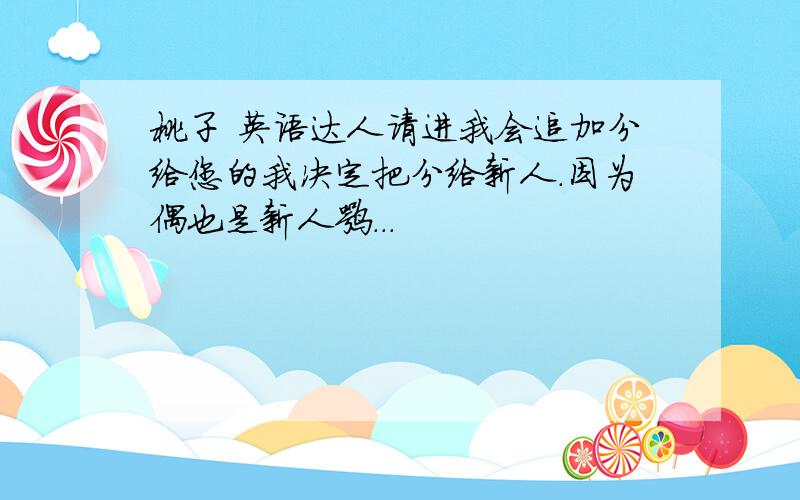桃子 英语达人请进我会追加分给您的我决定把分给新人.因为偶也是新人嘛...
来源:学生作业帮助网 编辑:作业帮 时间:2024/11/05 19:43:07

桃子 英语达人请进我会追加分给您的我决定把分给新人.因为偶也是新人嘛...
桃子 英语达人请进
我会追加分给您的
我决定把分给新人.因为偶也是新人嘛...
桃子 英语达人请进我会追加分给您的我决定把分给新人.因为偶也是新人嘛...
Peaches can be red,pink,yellow,white,or a combination of those colors.On one side of the fruit is a distinctive vertical indentation.Peaches and nectarines look very similar,but they can be told apart by their skin texture:peaches are fuzzy and dull,while nectarines are smooth and shiny.
Native to China, this fruit came to Europe (and subsequently to the New World) via Persia, hence its ancient appellation Persian apple. Throughout its evolution, the peach has propagated hundreds of v...
全部展开
Native to China, this fruit came to Europe (and subsequently to the New World) via Persia, hence its ancient appellation Persian apple. Throughout its evolution, the peach has propagated hundreds of varieties that vary greatly in color and flavor. In general, a peach falls into one of two classifications-freestone, in which case the stone or pit falls easily away from the flesh, and clingstone, where the fruit adheres stubbornly to the pit. It's the freestones that are more commonly found in markets, while the firmer-textured clingstones are widely used for commercial purposes. The peach's velvety skin can range from pink-blushed creamy-white to red-blushed yellow and its flesh from pinkish-white to yellow-gold. Peaches are available from May to October in most regions of the United States. Southern hemisphere imports are frequently found in coastal cities during the winter. Look for intensely fragrant fruit that gives slightly to palm pressure. Because peaches bruise easily they should be thoroughly perused for soft spots. Avoid those with signs of greening. To ripen underripe peaches, place them in a paper bag, pierce the bag in several places, and set it aside at room temperature for a couple of days. Adding an apple to the bag will speed ripening because apples exude ethylene gas, which speeds the ripening process. Refrigerate ripe peaches in a plastic bag for up to 5 days. Bring to room temperature before eating. Because of their fuzzy skins, peaches are often peeled before eating. This can be done easily by blanching the peach in boiling water for about 30 seconds, then plunging it into icy-cold water. Canned peaches are available, sliced or in halves, packed either in sugar syrup or water. Frozen peach slices are also available, as are dried peach halves. Peaches contain both vitamins A and C.
收起
Correct positioning and soil type are the key to growing peaches successfully. Peaches produce blossom in early spring and this can easily be damaged by frosts. For this reason a south-facing wall (ho...
全部展开
Correct positioning and soil type are the key to growing peaches successfully. Peaches produce blossom in early spring and this can easily be damaged by frosts. For this reason a south-facing wall (house walls are ideal) protected from wind is the only satisfactory site. A fully-grown fan peach tree will have a spread of approximately 5m (16ft) and a height of 2.5m (8ft), so the wall needs to be large enough to allow for this growth. Also bear in mind that wire supports will need to be nailed to the wall to train the branches.
The soil should be well-dug to a depth of 75cm (2ft 6in) a couple of months before planting with plenty of compost being added.
The aim is to ensure that the soil is capable of holding water, but at the same time drain well. The soil should be medium (neither too acidic nor too alkaline).
收起
A deciduous fruit tree species (Prunus persica) that originated and was first cultivated in western China. It is adapted to relatively moderate climates in the temperate zone. Although most peach cult...
全部展开
A deciduous fruit tree species (Prunus persica) that originated and was first cultivated in western China. It is adapted to relatively moderate climates in the temperate zone. Although most peach cultivars require a substantial amount of winter chilling (temperatures between 32 and 45°F, or 0–7°C) to ensure adequate breaking of winter dormancy and uniform budbreak, peach wood is susceptible to winter injury at temperatures below −15°F (−25°C) and dormant fruit buds are injured by temperatures below 0°F (−18°C). Consequently, commercial cultivation is limited to lower latitudes in the temperate zone or to higher latitudes where large bodies of water have a moderating influence on climate. The principal peach-growing regions in North America, ranked in order of commercial production, are central California, Georgia and the Carolinas, the mid-Atlantic region, the Great Lakes region, and the Pacific northwestern region. Other important peach-growing regions in the world include Italy, southern France, Spain, Japan, China, Argentina, southern Brazil, Chile, South Africa, and southeastern Australia. See also Fruit; Fruit, tree; Rosales.
Peach cultivars can vary greatly and are usually distinguished by their fruit types. Peach fruits are covered with short epidermal trichomes called fuzz (smooth-skinned peaches are called nectarines) and at maturity are usually yellow or white with a red blush. The internal flesh is also yellow or white. Clingstone cultivars have a relatively firm flesh that adheres to the pit at maturity, and are primarily used for canning. Freestones usually have a softer flesh that separates from the pit at fruit maturity, and are primarily used for the fresh market, freezing, and drying.
--------------------------------------------------------------------------------
收起